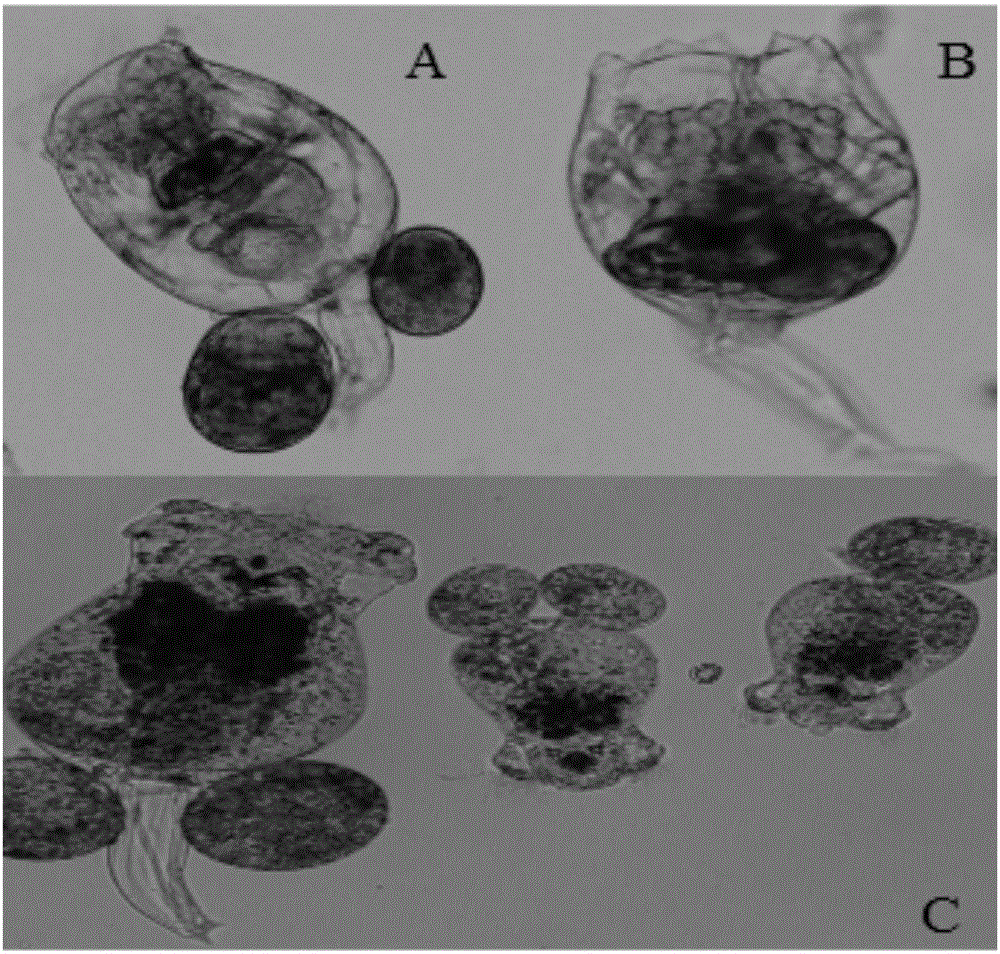Method improving wheel animalcule growth reproduction capacity and intensifying action of wheel animalcule working as bait nutrient
A technology of fecundity and rotifers, applied in animal feed, animal feed, application, etc., can solve the impact of aquatic animal survival rate, growth rate and disease resistance, cannot meet the huge demand of aquatic products, and limit the supply of single-cell microalgae To achieve the effect of increasing comprehensive production efficiency, improving aquaculture efficiency, and improving growth and reproduction capacity
- Summary
- Abstract
- Description
- Claims
- Application Information
AI Technical Summary
Problems solved by technology
Method used
Image
Examples
Embodiment 1
[0025] Get 3 10-liter culture water tanks, add 8 liters of 25‰ seawater therein, and inoculate isodense rotifers (16 / ml), and fully aerate and cultivate for 8 days. Wherein add 3.0g fresh Nannochloropsis mud every day in an incubator; And add the fresh algae mud of equal weight Nannochloropsis and 1.5% Haematococcus fresh algae mud mixed product in another incubator, wherein The mass ratio of Chlorella and Haematococcus is 4:1 (that is, Haematococcus accounts for 20% of the total bait); figure 1 ).
[0026] The results showed that the growth and reproduction of the rotifers in the microalgae-fed group 2 was better than that in the yeast-fed group, and the rotifers in the group fed with Nannochloropsis and Haematococcus had the best growth and the fastest reproduction rate, and the density of rotifers The highest, containing 160 rotifers per milliliter, about 60% higher than the Nannochloropsis group fed alone (100 per milliliter); while the group fed yeast alone had the slowe...
Embodiment 2
[0030] Take another 3 10-liter culture water tanks, add 8 liters of 25‰ seawater therein, and inoculate the rotifers of isodensity (15 / ml), and fully aerate and cultivate for 6 days. Wherein, add 3.0g fresh Nannochloropsis algae mud (approximately 0.86g dry weight) to one incubator every day; Chlorella algae residue mixed product, wherein, the added amount of Chlorella accounts for 70% of the total added mass, and the added amount of Haematococcus accounts for 30% of the total added mass; in addition, add 3.0g fresh Yeast, as a control.
[0031] The experimental results show a similar effect to that of Example 1: the growth and reproduction effect of the rotifers fed with the second group of microalgae is significantly better than that of the yeast group fed alone, wherein the rotifers fed with Nannochloropsis and Haematococcus algal residues grow The best, the fastest reproduction rate, the highest rotifer density, 100 rotifers per milliliter, which is about 60% higher than ...
Embodiment 3
[0034]Further use of Haematococcus broken wall algae powder containing 4.0% astaxanthin and 2.0% Haematococcus broken wall fresh algae mud were mixed with Nannochloropsis respectively, and the above-mentioned rotifer feeding experiment was carried out again. Also obtain similar results similar to implementation cases 1 and 2. Among them, after Haematococcus algae powder and algae mud are broken, the particles are smaller, which is more conducive to the feeding and absorption of rotifers, and the growth and reproduction of rotifers and eggs are increased. There was an increase in growth, reproduction and fecundity, but no statistically significant difference was observed between the two.
PUM
 Login to View More
Login to View More Abstract
Description
Claims
Application Information
 Login to View More
Login to View More - R&D
- Intellectual Property
- Life Sciences
- Materials
- Tech Scout
- Unparalleled Data Quality
- Higher Quality Content
- 60% Fewer Hallucinations
Browse by: Latest US Patents, China's latest patents, Technical Efficacy Thesaurus, Application Domain, Technology Topic, Popular Technical Reports.
© 2025 PatSnap. All rights reserved.Legal|Privacy policy|Modern Slavery Act Transparency Statement|Sitemap|About US| Contact US: help@patsnap.com

